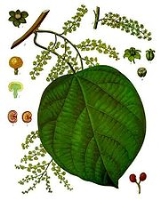
Anamirta cocculus
Overview
Southeast Asia
Southeast Asia, South-East Asia, South East Asia or Southeastern Asia is a subregion of Asia, consisting of the countries that are geographically south of China, east of India, west of New Guinea and north of Australia. The region lies on the intersection of geological plates, with heavy seismic...
n and Indian climbing plant. Its fruit
Fruit
In broad terms, a fruit is a structure of a plant that contains its seeds.The term has different meanings dependent on context. In non-technical usage, such as food preparation, fruit normally means the fleshy seed-associated structures of certain plants that are sweet and edible in the raw state,...
, Cocculus indicus, is the source of picrotoxin
Picrotoxin
Picrotoxin, also known as cocculin, is a poisonous crystalline plant compound, first isolated by Pierre Boullay in 1812. The name "picrotoxin" is a combination of the Greek words "picros" and "toxicon" ....
, a poison
Poison
In the context of biology, poisons are substances that can cause disturbances to organisms, usually by chemical reaction or other activity on the molecular scale, when a sufficient quantity is absorbed by an organism....
ous alkaloid
Alkaloid
Alkaloids are a group of naturally occurring chemical compounds that contain mostly basic nitrogen atoms. This group also includes some related compounds with neutral and even weakly acidic properties. Also some synthetic compounds of similar structure are attributed to alkaloids...
with stimulant properties.
The plant is large-stemmed (up to 10 cm in diameter); the bark is "corky gray" with white wood. The "small, yellowish-white, sweet-scented" flowers vary between 6 to 10 centimeters across; the fruit produced is a drupe
Drupe
In botany, a drupe is a fruit in which an outer fleshy part surrounds a shell of hardened endocarp with a seed inside. These fruits develop from a single carpel, and mostly from flowers with superior ovaries...
, "about 1 cm in diameter when dry".
The stem and the roots contain quaternary alkaloid
Alkaloid
Alkaloids are a group of naturally occurring chemical compounds that contain mostly basic nitrogen atoms. This group also includes some related compounds with neutral and even weakly acidic properties. Also some synthetic compounds of similar structure are attributed to alkaloids...
s, such as berberine
Berberine
Berberine is a quaternary ammonium salt from the protoberberine group of isoquinoline alkaloids. It is found in such plants as Berberis Berberine is a quaternary ammonium salt from the protoberberine group of isoquinoline alkaloids. It is found in such plants as Berberis Berberine is a quaternary...
, palmatine
Palmatine
Palmatine is a protoberberine alkaloid found in several plants including Phellodendron amurense, Rhizoma coptidis/Coptis Chinensis and Corydalis yanhusuo.It is the major component of the protoberberine extract from Enantia chlorantha....
, magnoflorine and colunibamine.
Unanswered Questions

